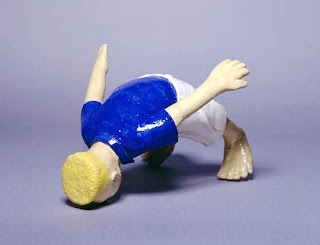In the past, feathered peacock asana was an asana that caused
me a lot of fear and anxiety. So it was no surprise to me when my students
looked at me like I had three heads when I told them that we were moving
towards this asana during my 9:15 a.m. Monday class. Luckily, they breathed and
opened to the pose. One of my students even helped me demonstrate by coming all
the way up into the asana. A shout out to Micaela for being open and exploring
a new pose :)
I, personally, am still working on this asana at the wall.
So, I encourage you to face your fears and spread your feathered peacock wings.
Sanskrit: Pincha Mayurasana Western Term: Forearm Balance/Feathered
Peacock Asana
Origin of Word
Pinca = feather; mayura = peacock
Type of Asana:
inversion
How To:
1.
If you feel more comfortable, take your mat
toward a wall rather than in the middle of the room. Take a block and bring it
in between your hands, bringing the longer area of the block on the ground in
between your hands.
2.
Place your pointer finger and thumb around the
block and keep your wrists in line with your elbows, shoulder width apart. Bring
your shoulders over your elbows and come into a forearm plank.
3.
Walk your feet in towards your forearms to come
into a dolphin pose (forearm down dog). Krama
or “stage one:” inhale as you reach your heels up lengthening and opening your
shoulders, exhale as you lower the heels down toward the ground. You can stay
raising and lowering your heels or move towards something affectionately called
“donkey kicks.” Donkey kicks begin by moving both feet in towards the midline
of your body. Keep the left foot grounding down, raise the right leg up towards
the sky. Bend the left knee and kick the right leg up towards the sky bringing
the left leg with you. Make sure you do both sides! If you feel ready, reach
one leg up and the other up in the air to meet it.
4.
Stay up for as long as you can! Make sure you
rest in balasana (child’s pose) for
as long as you were up.
Body Points:
*Feel pada bandha through
the balls of the feet
*Squeeze your inner thighs and lengthen through your
shoulders
*Spread your fingers and engage the core to stay upright
Emphasized Body
Parts: brain, pituitary, arms, shoulders, legs, spine, and lungs
Don't hit your head against the floor...relieve your stress with Pincha Mayurasana. And please don't attempt to stand on your forehead...ouch.
Mental Achievements:
Great pose to relieve stress! Pincha
Mayurasana calms the brain and helps relieve stress and mild depression
An aid for beginners:
kramas or levels of a pose give us
yogis with various levels options. For any given pose, there are various levels
of difficulty. This krama that I
offer is for beginners to the pose:
-if you find it difficult to keep your elbows shoulder
distance without letting your elbows splay away from one another further, make
a loop with a strap and place it over your upper arms (above the elbow). Use
the strap in the pose, but think of pushing the arms slightly toward your midline
rather than letting them bulge out toward the strap.
Chakra: 5th
chakra, Visuddha chakra is symbolized by a blue sixteen-petaled lotus found in your
throat. The throat chakra helps improve your communication.
-The “seed sound” or bija
mantra is “ham.” Repeat this seed
sound in a 5th chakra poses like forearm balance to help improve
your communication and creativity.
Ancient Sanskirt
Proverb: “Why should men endowed with good sense speak harshly, when
sweetness is within their own power and when sentences can be composed with
sweet words.”
Element: sound
Yogi Tune of the
Week: “Om Namo Bhagavate” by Veronique Dumont & Rogerio Jardim in their
album “Shiva-Shakti Mantras”
*Do not perform
forearm balance if you experience back, shoulder or neck injury, headache,
heart condition, high blood pressure, or menstruation.
Happy Friday to all! I leave you with these 3 images to ponder...
Seriously don't...
Happy Passover & Easter :)
Happy 22nd Birthday to my feather peacock, Jasp! Ok, he was dressed as an avatar in this picture but may as well have been a feathered peacock. Love you!!! Boop!
Sources:
http://www.yogajournal.com/poses/1711.
Viewed 3/27/13.
http://www.tulaa7.com/chakra5-blue.html.
Viewed 3/27/13.























